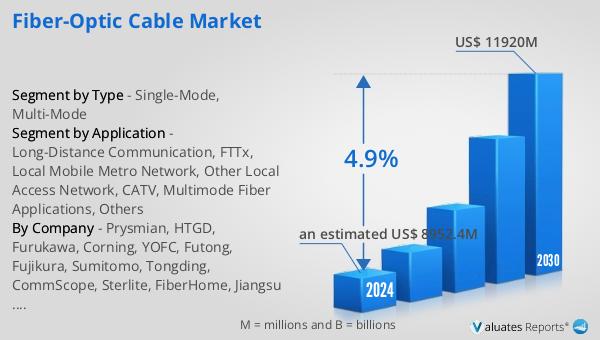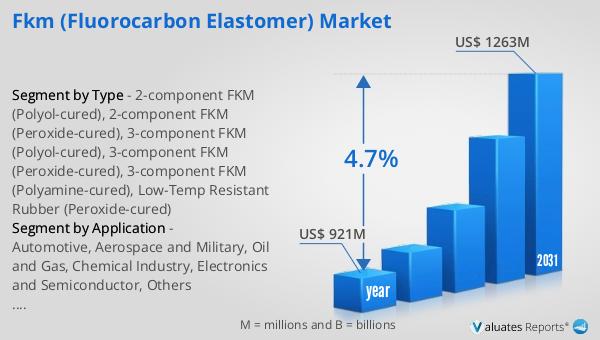What is Global Fiber-optic Cable Market?
The global fiber-optic cable market is a rapidly evolving sector that plays a crucial role in modern telecommunications and data transmission. Fiber-optic cables use light to transmit data at incredibly high speeds, making them essential for internet services, cable television, and long-distance communication. These cables are made of thin strands of glass or plastic fibers that carry data signals in the form of light pulses. The market for fiber-optic cables is expanding due to the increasing demand for high-speed internet and the growing need for efficient data transmission in various industries. Technological advancements and the rising adoption of fiber-optic technology in emerging economies are also driving market growth. The global fiber-optic cable market is expected to continue its upward trajectory, fueled by the ongoing digital transformation and the increasing reliance on high-speed data networks.

Single-Mode, Multi-Mode in the Global Fiber-optic Cable Market:
Single-mode and multi-mode fiber-optic cables are two primary types used in the global fiber-optic cable market, each serving different purposes based on their unique characteristics. Single-mode fiber-optic cables have a small core diameter, typically around 9 micrometers, which allows only one mode of light to propagate. This design minimizes signal attenuation and dispersion, making single-mode fibers ideal for long-distance communication and high-bandwidth applications. They are commonly used in telecommunications, internet backbones, and long-haul networks where data needs to travel over vast distances without significant loss of signal quality. On the other hand, multi-mode fiber-optic cables have a larger core diameter, usually around 50 or 62.5 micrometers, which allows multiple modes of light to propagate simultaneously. This results in higher signal attenuation and dispersion compared to single-mode fibers, limiting their effective transmission distance. However, multi-mode fibers are well-suited for shorter-distance applications, such as within data centers, local area networks (LANs), and campus networks, where high data transfer rates are required over relatively short distances. The choice between single-mode and multi-mode fiber-optic cables depends on the specific requirements of the network, including distance, bandwidth, and cost considerations. Single-mode fibers are generally more expensive due to their advanced technology and longer transmission capabilities, while multi-mode fibers offer a cost-effective solution for shorter-distance, high-speed data transmission. Both types of fiber-optic cables play a vital role in the global fiber-optic cable market, catering to diverse applications and industries.
Long-Distance Communication, FTTx, Local Mobile Metro Network, Other Local Access Network, CATV, Multimode Fiber Applications, Others in the Global Fiber-optic Cable Market:
The global fiber-optic cable market finds extensive usage in various areas, including long-distance communication, FTTx (Fiber to the x), local mobile metro networks, other local access networks, CATV (Cable Television), multimode fiber applications, and others. In long-distance communication, fiber-optic cables are indispensable due to their ability to transmit data over vast distances with minimal signal loss and high bandwidth capabilities. This makes them ideal for connecting cities, countries, and even continents, ensuring reliable and high-speed data transmission. FTTx refers to the deployment of fiber-optic cables to provide high-speed internet and other services directly to homes, businesses, and other premises. This includes Fiber to the Home (FTTH), Fiber to the Building (FTTB), and Fiber to the Curb (FTTC), among others. FTTx deployments are crucial for delivering ultra-fast internet speeds and supporting the growing demand for bandwidth-intensive applications such as streaming, online gaming, and cloud services. Local mobile metro networks rely on fiber-optic cables to connect cell towers and base stations, enabling high-speed data transfer and supporting the increasing data traffic generated by mobile devices. Fiber-optic cables are also used in other local access networks to provide high-speed connectivity to businesses, educational institutions, and government facilities. In the CATV industry, fiber-optic cables are used to deliver high-quality television signals and internet services to subscribers. Multimode fiber applications are prevalent in data centers, where high-speed data transfer over short distances is essential for efficient operation. Other applications of fiber-optic cables include industrial automation, medical imaging, and military communications, where reliable and high-speed data transmission is critical. The versatility and high performance of fiber-optic cables make them a preferred choice for various applications, driving their demand in the global market.
Global Fiber-optic Cable Market Outlook:
The global fiber-optic cable market is anticipated to grow significantly, with projections indicating it will reach approximately $11,920 million by 2030, up from an estimated $8,952.4 million in 2024, reflecting a compound annual growth rate (CAGR) of 4.9% between 2024 and 2030. The market is dominated by the top five manufacturers, who collectively hold around 40% of the market share. The Asia-Pacific region is the largest market for fiber-optic cables, accounting for over 60% of the global market share, followed by North America, which holds about 16%. This growth is driven by the increasing demand for high-speed internet, advancements in telecommunications infrastructure, and the rising adoption of fiber-optic technology in various industries. The expansion of the fiber-optic cable market is also supported by the ongoing digital transformation and the need for efficient data transmission solutions. As the demand for high-speed data networks continues to rise, the global fiber-optic cable market is expected to maintain its growth trajectory, providing opportunities for manufacturers and stakeholders in the industry.
| Report Metric | Details |
| Report Name | Fiber-optic Cable Market |
| Accounted market size in 2024 | an estimated US$ 8952.4 million |
| Forecasted market size in 2030 | US$ 11920 million |
| CAGR | 4.9% |
| Base Year | 2024 |
| Forecasted years | 2024 - 2030 |
| Segment by Type |
|
| Segment by Application |
|
| By Region |
|
| By Company | Prysmian, HTGD, Furukawa, Corning, YOFC, Futong, Fujikura, Sumitomo, Tongding, CommScope, Sterlite, FiberHome, Jiangsu Etern, ZTT, Belden, Nexans, Kaile, LS Cable&System |
| Forecast units | USD million in value |
| Report coverage | Revenue and volume forecast, company share, competitive landscape, growth factors and trends |
